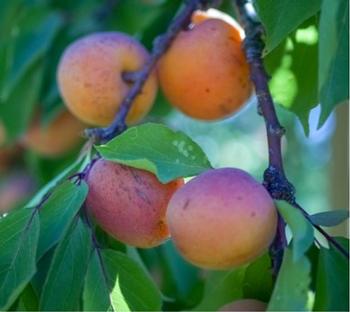Apricot
-
Scientific NamePrunus armeniaca
-
General InformationApricots bloom in February and early March, which can coincide with cold rain storms. As a result, consistent crops are unlikely in Marin. However, when one does get a crop it's worth the wait. Apricots perform best where spring weather is dry. They are susceptible to late spring frosts and do not do well in areas with summer fog.
 Photo: Ryk Porras/Unsplash
Photo: Ryk Porras/Unsplash -
When to Plant
Apricot trees need full sun, good air movement, and well-drained soil at least four feet deep. They require 600 to 900 chill hours (temperatures below 45° F). There are a few low-chill varieties that will bear with only 350 hours. Because of the early blooming habit of apricots, avoid planting where late spring frost occurs to avoid light crops. High temperatures also influence the quality of fruit. In areas of high rainfall, apricots do not regularly set fruit and are subject to many diseases.
-
Planting
Apricots are best adapted to areas with adequate chilling, which for apricots is 600 to 900 hours below 45° F. There are a few low-chill varieties that will bear with only 350 hours. Because of the early blooming habit of apricots, avoid planting where late spring frost occurs to avoid light crops. High temperatures also influence the quality of fruit. In areas of high rainfall, apricots do not regularly set fruit and are subject to many diseases.
Apricot trees do best in areas with full sun, good air movement, and well-drained soils at least four feet deep.
On a ridge or berm (or create a mound), dig a hole at least twice the diameter of the container (use two feet as a guide if bare root tree did not come in a container), with a depth of two inches less than the distance between the crown and the root ball. The two inch depth difference will ensure the plant sits slightly higher than the soil line. Shape the hole with slightly sloping sides.
Gently untangle the roots, removing any shoots within six inches of soil, and place the root ball on firm soil to avoid settling, and spread out the roots. Fill with original soil and create a water basin away from the trunk. Apply a thin layer of organic matter/mulch three inches away from the trunk.
Learn more about planting bare root trees.
-
Soil Requirements
Apricots prefer fertile, slightly acidic, sandy loam free of alkali or salinity.
-
Water Requirements
After planting in winter/spring and watering initially, use rainfall as a guide to keep the soil moist. Apricots require irrigation during the growing season and summer months. For smaller trees, water deeply and slowly, away from the trunk, every one to two weeks. If winter rains do not wet the entire root zone, be sure to remedy this with your own irrigation practices. For larger trees, irrigate deeply and less frequently, ensuring the entire root zone is re-wetted with each irrigation.
-
Fertilizing
Nitrogen in spring, additional applications based on tree age, health, and soil quality.
-
Pollination
Most apricot varieties are self-fertile and do not require supplemental bee pollination to set fruit.
-
Harvesting
Apricots ripen in late June to July (100 to 120 days from full bloom).
-
Storage
Fruit may be stored briefly at room temperature, or for longer periods in the refrigerator. Drying is also a great way to preserve apricots.
-
Good Varieties for Marin
Chill hour requirements:
'Blenheim' -- 400 to 500
'Katy' -- 350
'Moorpark' – 600 to 700
-
Helpful Tips
Apricots perform best in climates with dry spring weather. They are susceptible to late spring frosts. Prune trees before the onset of winter rains
(by early September) to prevent Eutypa fungus infection of pruning wounds.Keep full sized trees 10 to 14 feet in height for ease of care and harvest. Prune trees before the onset of winter rains (by early September) to prevent Eutypa fungus infection of pruning wounds.
Spring: remove all weeds from the tree base to reduce competition and pest problems. Fertilize. Dormant spray with copper fungicide as flowers open to prevent brown rot.
Summer: Harvest. Keep tree base dry to reduce crown rot problems, ensuring drip line or watering is away from the trunk. Remove dead, diseased, broken, and interfering limbs.
Learn more on pruning apricot trees.
-
Common Problems
Pocket gophers can injure or kill a tree by feeding on the roots. Consider trapping.
-
Pests- Diseases & More
Bacterial canker is a disease that can kill young trees, but is not serious in mature trees. Masses of amber-colored gum are produced on affected branches and wood becomes malformed.
Learn more about growing apricots.

